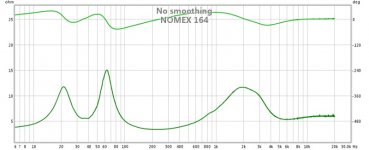You could swap and see. I don't suppose the mic is muted in the windows mixer or something? I've never used REW. You're super sure the signal isn't getting shorted to ground somewhere, right?
Last edited:
i'm swapping them now. not sure where the window mixer is. I'm using realtek HD audio manager from the system tray. windows 7
I get no input with them switched, even with mic level at max and 30 db boost. With them in the original position I have to have them up to not get error.
Maybe back up for a minute, disconnect all that, and see if you can make a recording of something, anything, plugged into the input.
I'm guessing there is a problem with the realtek settings. Some of their newer ones have a ton of software control over what all the jacks actually do.
It's a few years old, but I try searching for a different control panel. I have gotten it to smooth out by lowering the mic, but now the impedance sweep is pretty much flat. do I need to figure out the impedance of the leads and enter that? is entering the measured value of the resistor the correct way to go? what about calibrating the sound card? I've done that but maybe it's wrong.
Man, I don't know. I tried the rear mic input just to see, same thing. I get differing readings all the time and I don't get that. Now I'm getting almost flat responses. This seems like a waste of time I guess.
Well, if it's applying a soundcard calibration that looks crazy (I think it lets you see the calibration curve when you do it?), that needs to be addressed, but otherwise don't worry about it. You don't really need to worry about the accuracy-related aspects for what you're doing, you just need a clean result. I've got another idea if you can't get it, though: you said it works with your receiver mic, so see if you can get response measurements to work. They will be horribly inaccurate, but you could still probably see the tuning frequency if you put the mic right up to a woofer cone.
I'm not sure what the curve is supposed to look like. This is what I got:
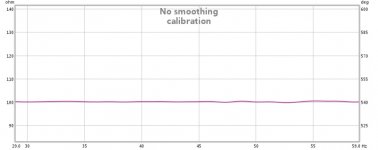
What looks odd is the impedance curve; it practically flat. I will try the mike, what type of measurement will I be doing? I assume I won't choose impedance.
I was hoping to check box resonance and crossover also, but oh well.

What looks odd is the impedance curve; it practically flat. I will try the mike, what type of measurement will I be doing? I assume I won't choose impedance.
I was hoping to check box resonance and crossover also, but oh well.
Okay, I think I finally got it working relatively well. Thank you dumptruck and Pascal for your help, really appreciate it. This was really frustrating. I had the left and right switched for the mic, but whenever I tried switching them it didn't work. I found out that you have to restart rew whenever you unplug anything.
So here is what I have so far:
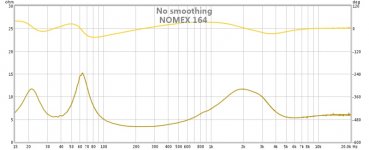
I'm still adjusting, trying to get the noise down. do I need to enter the lead impedance to make it more accurate?
So here is what I have so far:

I'm still adjusting, trying to get the noise down. do I need to enter the lead impedance to make it more accurate?
Hi Satx,
Nice to see that you've been able to realize the measurement 🙂
The box tuning value is where the phase curve cross the zero line and where you find the minimum SPL between the two pics on the SPL curve.
It's around 35 Hz, so much lower than you were thinking.
When you see a little bump or oscillations it means that there is resonnance at this frequency, resonnance may come from the box or/and the speaker. If you measure only the speaker out of the box it can give you an idea. From your curve it seems thta there is something around the tuning frequency, are your box/speaker really well air tight ?
Nice to see that you've been able to realize the measurement 🙂
The box tuning value is where the phase curve cross the zero line and where you find the minimum SPL between the two pics on the SPL curve.
It's around 35 Hz, so much lower than you were thinking.
When you see a little bump or oscillations it means that there is resonnance at this frequency, resonnance may come from the box or/and the speaker. If you measure only the speaker out of the box it can give you an idea. From your curve it seems thta there is something around the tuning frequency, are your box/speaker really well air tight ?
Last edited:
Hi Pascal,
Yes I noticed the Tuning point was low. I pulled a port last night and realized that I had cut it to 3.75 based on the calculator I was using. I will adjust and remeasure. The only place I may have an air leak is the bottom. I made the bottom removable for the crossover access. It has a good gasket, but I'll take a look. That is exactly the info I was looking for from this measurement thanks.
Here is another graph, I think everything's set up pretty well now; I have gotten all the noise out and adjusted the resistor.
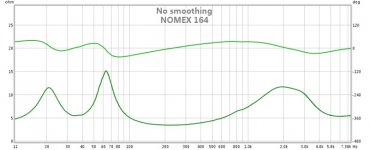
Still a little ripple at tuning freq. What about bump at 800hz?
I have adjusted L-pad with 1.2 and 15. I like it a lot, much smoother. still deciding if it makes it a touch boring though. we'll see.
Evan
Yes I noticed the Tuning point was low. I pulled a port last night and realized that I had cut it to 3.75 based on the calculator I was using. I will adjust and remeasure. The only place I may have an air leak is the bottom. I made the bottom removable for the crossover access. It has a good gasket, but I'll take a look. That is exactly the info I was looking for from this measurement thanks.
Here is another graph, I think everything's set up pretty well now; I have gotten all the noise out and adjusted the resistor.

Still a little ripple at tuning freq. What about bump at 800hz?
I have adjusted L-pad with 1.2 and 15. I like it a lot, much smoother. still deciding if it makes it a touch boring though. we'll see.
Evan
Congrats! Are you using averaging? Environmental noise can cause blips in these tiny signal measurements. The 800Hz thing was probably a woofer resonance, although Troels doesn't show it (he does have a 150Hz bump that you don' have, though).

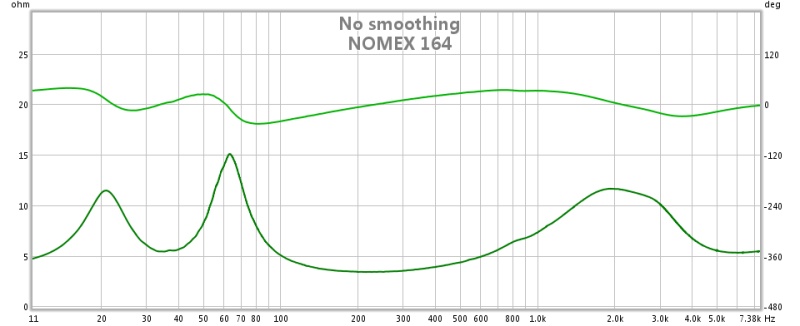


Congrats! Are you using averaging? Environmental noise can cause blips in these tiny signal measurements. The 800Hz thing was probably a woofer resonance, although Troels doesn't show it (he does have a 150Hz bump that you don' have, though).
Thanks! I don't know how to use averaging. He talks about the blip at 180hz, I think stuffing the top and bottom removed it. Should I try to control the woofer resonance.
Evan
I have post a short build thread so take a look if you'd like.
http://www.diyaudio.com/forums/multi-way/224745-troels-nomex-164-build.html
Thanks,
Evan
http://www.diyaudio.com/forums/multi-way/224745-troels-nomex-164-build.html
Thanks,
Evan
Lots of soft cone woofers show small resonances around 800Hz, there is no need to try and remove it. It looks like the stuffing did the trick on the 180Hz resonance, it's all good thinking that it will, but it's another seeing it proven right.
Good job.
Good job.
Thanks 5th
It certainly is another thing seeing it for yourself. I really wanted to get REW working. Now I know for sure where the tuning freq really is. I'm going to cut the port shorter and re measure; I'm not entirely happy with the bass, it's strong but something seems a little off sometimes.
It certainly is another thing seeing it for yourself. I really wanted to get REW working. Now I know for sure where the tuning freq really is. I'm going to cut the port shorter and re measure; I'm not entirely happy with the bass, it's strong but something seems a little off sometimes.
- Home
- Loudspeakers
- Multi-Way
- Troels NOMEX 164: any thoughts
